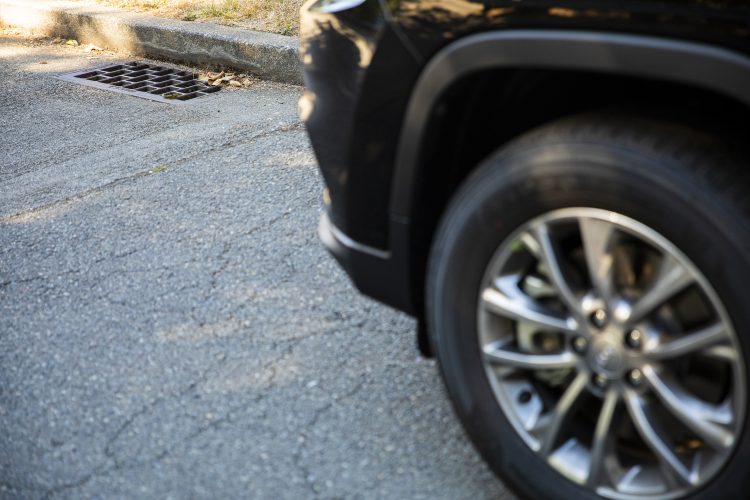
Car tyres produce vastly more particle pollution than exhausts, tests show
Toxic particles from tyre wear almost 2,000 times worse than from exhausts as weight of cars increases

I honestly find that hard to believe. But I certainly could be wrong
Car tyres produce vastly more particle pollution than exhausts, tests show
Toxic particles from tyre wear almost 2,000 times worse than from exhausts as weight of cars increaseswww.theguardian.com
As do I, especially when heavy vehicle emissions are considered.I honestly find that hard to believe.

Bathing, I'll take the tires, breathing the particulate, it's a tossup. Volcanized rubber and silica dust cannot be good for lung function.I have no trouble believing that more mass in particulates are generate by tire wear, than coming out the tailpipe of nearly any vehicle. No surprise in that, whatsoever.
Where I fall off their bandwagon is when the imply that the impact of the types of particulates are somehow comparable. I think the jury is still out on that, but if you were to force me to make a choice of climbing into a vat of particulates from my exhaust pipe versus my tires, I'll be bathing in tire.
The silica is potentially a problem and can lead to silicosis if you live or work near a freeway or really busy road. Especially one traveled by heavy vehicles. I'm sure silica dust paired with ICE emissions can't be good for health.Sigh. This 'news' has gotten filtered through the internet a few times, and popped up in my feed as 'EVs wear tires 2x faster than regular cars, thus the pollution from EVs is 4000X worse than the tailpipe pollution of regular cars.' Of course they did.
I looked up some studies. No evidence that tire wear particles are particularly toxic. They are large, so most of the mass falls out of the air quickly. They merge with soil and wash into waterways. In water, they are denser than water, so they sink. The polymer component is mostly isoprene which DOES biodegrade (and photodegrade). Carbon black and silica fillers are already in the environment in large amounts.
Toxicity concerns seem to revolve around minor components that are mildly toxic, like Zinc. Yawn.
Ofc similar studies on diesel particles confirms they are VERY toxic, related to heart disease and Alzheimers.
Some press coverage is calling this 'microplastics' and equating it with other microplastics (as in the marine environment). No one has shown significant tire particles in the surface marine environment, bc, gravity.
The silica is potentially a problem and can lead to silicosis if you live or work near a freeway or really busy road. Especially one traveled by heavy vehicles. I'm sure silica dust paired with ICE emissions can't be good for health.
Good point, as it’s not apples to apples. The biggest benefit of an EV is a short to moderate commute in congested traffic, like California. Where the ICE is running nonstop, while the EV is only using enough power to run the electronics and maybe the AC, while creeping along. And at low speeds, tire fragments are minimal.Sigh. This 'news' has gotten filtered through the internet a few times, and popped up in my feed as 'EVs wear tires 2x faster than regular cars, thus the pollution from EVs is 4000X worse than the tailpipe pollution of regular cars.' Of course they did.
I looked up some studies. No evidence that tire wear particles are particularly toxic. They are large, so most of the mass falls out of the air quickly. They merge with soil and wash into waterways. In water, they are denser than water, so they sink. The polymer component is mostly isoprene which DOES biodegrade (and photodegrade). Carbon black and silica fillers are already in the environment in large amounts.
Toxicity concerns seem to revolve around minor components that are mildly toxic, like Zinc. Yawn.
Ofc similar studies on diesel particles confirms they are VERY toxic, related to heart disease and Alzheimers.
Some press coverage is calling this 'microplastics' and equating it with other microplastics (as in the marine environment). No one has shown significant tire particles in the surface marine environment, bc, gravity.
Well then, thanks for the correction.Amorphous silica (as in tires) does not cause silicosis. It is listed as an eye irritant.

I can already see tomorrow's news feed, after that's been filtered through, a few times: "We need tougher fish".Ironically, an additive in tire compounds that makes them wear longer is toxic, to fish at least and perhaps to other marine life. This was the finding of a research project led by the Univ. of Washington.
Tougher fish would be great. Most fish are very susceptible to poor water quality, especially freshwater fish which are constantly absorbing the water through their skin. Salmonid species in particular suffer from poor water quality the most, generally resulting in poor reproduction. There are only about 300-350k wild atlantic salmon left in the wild, compared to the untold millions that would congregate in one estuary prior to humans polluting and damming rivers.I can already see tomorrow's news feed, after that's been filtered through, a few times: "We need tougher fish".
I wonder if the new model will be anywhere near as disappointing as it's predecessor. There are very few products in history as simultaneously anticipated and disappointing, as the original Delrean. If it's image hadn't been somewhat resurrected by a popular movie, very few outside automotive enthusiast circles would even remember that turd of a car.The delorean is coming back I saw (as a BEV).

Well with generative breaking we can at least reduce the break wear products by choosing EVs. But some times those lights just turn yellow way to fast.My tires do seem to wear out faster on my Leaf than on my ICE vehicles but that might well be due to how much more fun I have driving it.
I guess I'm more concerned about what we don't know with respect to these types of emissions. Tires are not just natural rubber as many might think. In addition to relatively inert things like carbon black, they are composed of synthesized "rubber" compounds like polybutadiene that are notoriously recalcitrant to degradation in the environment. I think I'd feel a lot better if tire particles broke down more readily in the environment, but then intermediate products might well end up being more problematic than the original material so... (but not so much a problem with natural rubber).
Also, a material's physical properties rather than its chemical toxicity may be more of a problem in the environment. Suspended plastics that mimic food in aquatic systems come to mind. Sand, though inert, applied to roads for winter traction can have detrimental effects on benthic environments as bottom dwellers are basically displaced or suffocated. I'll also add the example of asbestos. Although chemically inert in our lungs, it still does a heck of a good job of causing cancer there.
I think sometimes we humans too easily let hubris get in the way of recognizing that we don't have all the answers when complex systems are involved.
Interesting related read here: https://www.nature.com/articles/d41586-021-01143-3
Also here where the aerial mobility of tire particles, among other things, is studied: https://www.nature.com/articles/s41467-020-17201-9
FYI, my understanding is that the amount of regen braking in L and D on the Volt (and the Bolt) are identical. The brake pedal is 'blended'. On other brands (like Tesla) the brake pedal is just calipers, and you need to use 1 pedal to get regen (or so I have heard, haven't driven one).So far our Volt's tires are on target for normal wear. At this rate we should see at least 40k miles out of them. Our brakes at 25k miles are like new, especially the rears. We always drive it in L, so lots of regenerative braking. This works out nicely in our hilly area.
I've driven a few Teslas, but never owned one. But my understanding of their behavior is the same as yours, and it certainly feels this way, when driving. When you take your foot off the accelerator, regen braking almost immediately engages, no need to move your foot to the brake pedal for regenerative braking to be felt or indicated. It is very noticeable if you're on a hill, a feeling similar to driving a manual transmission ICE car in a relatively low gear, or a modern auto trans in sport or track settings.FYI, my understanding is that the amount of regen braking in L and D on the Volt (and the Bolt) are identical. The brake pedal is 'blended'. On other brands (like Tesla) the brake pedal is just calipers, and you need to use 1 pedal to get regen (or so I have heard, haven't driven one).
We use essential cookies to make this site work, and optional cookies to enhance your experience.

